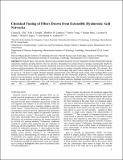Chemical Tuning of Fibers Drawn from Extensible Hyaluronic Acid Networks
Author(s)
Chu, Crystal K.; Joseph, Alby J.; Limjoco, Matthew D.; Yang, Jiawei; Bose, Suman; Thapa, Lavanya S.; Langer, Robert S; Anderson, Daniel Griffith; ... Show more Show less
DownloadAccepted version (17.86Mb)
Open Access Policy
Open Access Policy
Creative Commons Attribution-Noncommercial-Share Alike
Terms of use
Metadata
Show full item recordAbstract
© 2020 American Chemical Society. Polymer fibers with specific chemical and mechanical properties are key components of many biomaterials used for regenerative medicine and drug delivery. Here, we develop a bioinspired, low-energy process to produce mechanically tunable biopolymer fibers drawn from aqueous solutions. Hyaluronic acid (HA) forms dynamic cross-links with branched polyethylene glycol polymers end-functionalized with boronic acids of varied structure to produce extensible polymer networks. This dynamic fiber precursor (DFP) is directly drawn by pultrusion into HA fibers that display high aspect ratios, ranging from 4 to 20 μm in diameter and up to ∼10 m in length. Dynamic rheology measurements of the DFP and tensile testing of the resulting fibers reveal design considerations to tune the propensity for fiber formation and fiber mechanical properties, including the effect of polymer structure and concentration on elastic modulus, tensile strength, and ultimate strain. The materials' humidity-responsive contractile behavior, a unique property of spider silks rarely observed in synthetic materials, highlights possibilities for further biomimetic and stimulus-responsive fiber applications. This work demonstrates that chemical modification of dynamic interactions can be used to tune the mechanical properties of pultrusion-based fibers and their precursors.
Date issued
2020-11Department
Koch Institute for Integrative Cancer Research at MIT; Massachusetts Institute of Technology. Department of Chemical Engineering; Massachusetts Institute of Technology. Institute for Medical Engineering & ScienceJournal
Journal of the American Chemical Society
Publisher
American Chemical Society (ACS)
Citation
Chu, Crystal K. et al. "Chemical Tuning of Fibers Drawn from Extensible Hyaluronic Acid Networks." Journal of the American Chemical Society 142, 46 (November 2020): 19715–19721. © 2020 American Chemical Society
Version: Author's final manuscript
ISSN
0002-7863
1520-5126